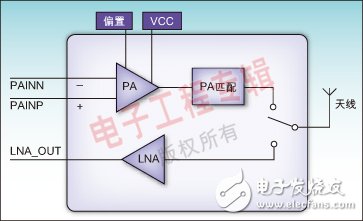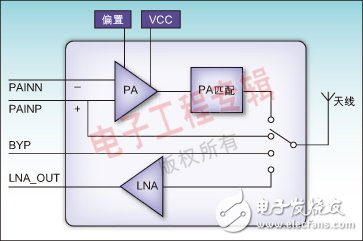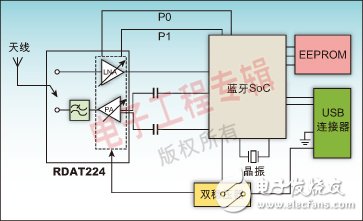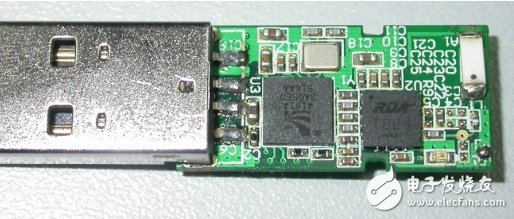Bluetooth communication is a time division multiplexing (TDD) technology that works in the 2.4GHz~2.48GHz frequency band. It is designed to replace cables to connect portable and/or fixed devices and ensure a high degree of security. The main characteristics of Bluetooth technology are powerful functions, low power consumption, low cost, and can handle data and voice transmission at the same time. According to the different transmission output power, Bluetooth transmission has 3 types of distance levels: Class1 is about 100 meters; Class2 is about 10 meters; Class3 is about 2 to 3 meters.
For long-distance Bluetooth technology applications, RDA Microelectronics has introduced RDAT224 and RDAT212 RF front-end module chips. RDAT224 chip integrates power amplifier (PA), low noise amplifier (LNA) and T/R radio frequency switch. The input and output of the chip have been matched to 50Ω inside the module. The packaging form adopts LGA suitable for the design of radio frequency modules, and the size is only 5&TImes;5mm2, which is very suitable for the design of USB Dongle Class1 products.
The RDAT212 chip also integrates PA, LNA and antenna switches, and especially increases the power saving functions of PA bypass and LNA bypass. The input and output of the chip have been matched to 50Ω inside the module, and the product size has been further reduced to 3&TImes;3mm2. The advantages of power saving and small size make the RDAT212 chip suitable for mobile Bluetooth and 802.11.b/g extended applications in the future.
At the same time, both products have good linearity and support high-speed applications of Bluetooth 2.0.
Internal circuit compositionThe integrated PA and LNA in the RDAT224 RF front-end module are manufactured using advanced gallium arsenide heterojunction bipolar transistor (GaAs HBT) process, and the T/R RF switch uses enhanced high electron mobility field effect transistor (E-PHEMT) Process manufacturing. Although the form of differential PA is not adopted, RDAT224 still provides differential input pins, so that users no longer need to care about the design of differential to single-ended.
PA has 20dB gain in the 2.4GHz~2.5GHz frequency band. In this way, the RDAT224 module can provide 20dBm output power under the condition of 0dBm input, which meets the power output requirements of Class1. The power added efficiency of PA at 21dBm output is as high as 40%, which helps to extend the power supply time.
The LNA has a gain of 15dB in the 2.4GHz~2.5GHz frequency band, the static operating current is only 9mA, the noise figure is less than 3dB, and the input third-order intermodulation point IIP3 is -5dBm.
The input and output of the module have been internally matched to 50Ω, and the customer does not need to design a matching circuit on the PCB during application, which makes the PCB design easier. The output harmonics of the PA have been suppressed to below -50dBc, and the external filter is usually no longer needed for application. In this way, only a small amount of filter capacitors are needed outside the module, which greatly reduces the PCB size and reduces the system cost.
RDAT212 adds the power saving functions of PA bypass and LNA bypass. In Class1 application, the module can provide 20dBm output power under the condition of 0dBm input; in Class2 application, the module can switch to PA bypass state again without consuming current.

Figure 1: Schematic diagram of the internal structure of RDAT224

Figure 2: Schematic diagram of the internal structure of RDAT212.
The LNA uses the E-PHEMT process, which further reduces the noise figure and improves the linearity. The LNA has a gain of 13dB in the 2.4GHz~2.5GHz frequency band, the static operating current is only 5mA, the noise figure is less than 2dB, and the input third-order intermodulation point IIP3 is as high as 8dBm. The LNA bypass function can not only be used as a power saving mode, but also can increase the dynamic range of the receiver.
The input and output of RDAT212 have been matched to 50Ω internally, and the harmonic suppression circuit is integrated inside the chip.
Principle of Application System Based on RDAT224The original Bluetooth design consisted of a series of separate ICs and supporting circuits and finally formed a Bluetooth module. With the advancement of technology, the integration level of Bluetooth design has been increasing, while the number of external devices has been decreasing.

Figure 3: System schematic diagram of Bluetooth adapter design.
Figure 3 shows a modular solution using the RDAT224 chip as the RF front-end module and a Bluetooth SoC as the baseband. The SoC is directly connected to PCs and other devices through a USB connector, completes the baseband function and up-converts the signal into a radio frequency signal and transmits it to the T224 radio frequency front-end module. It also provides control interfaces for T/R radio frequency switches, PA, and LNA. The RDAT224 RF front-end module amplifies the RF signal, and then transmits the signal to the antenna through the RF switch. The PA of RDAT224 provides an output of 20dBm, which can make the effective range of the Bluetooth adapter reach 100 meters. When the Bluetooth adapter receives the signal, the radio frequency signal is transmitted to the LNA via the radio frequency switch. The LNA noise figure of RDAT224 is less than 3dB, which can greatly improve the sensitivity of the receiving link. The radio frequency signal is amplified by the LNA and down-converted by the SoC, and transmitted to the PC and other devices by the USB connector.
Design and implementation skills and experienceThe RDAT224 RF front-end module integrates the T/R RF switch, PA and LNA, which greatly reduces the complexity of the Bluetooth module. If designers do not use the above-mentioned highly integrated modules, they must design the Bluetooth PCB very closely. Component placement, tracking scanning, decoupling, grounding, shielding, and board are all important factors that affect performance, especially the RF performance of the product. If RDAT224 is used, then the designer will be able to circumvent these problems, so there is no need to pay special attention to the above factors in the final design. In addition, RDAT224 can also help reduce the size of the PCB, further reducing costs. Figure 4 shows the PCB photo of the Bluetooth adapter. It can be seen that the area is very small, except for the RDAT224 chip and the Bluetooth SoC chip, there are few peripheral components.

Figure 4: PCB physical diagram of the Bluetooth adapter
Switchgear Circuit Breakers,Park Detroit Switchgear,Powergo-C40,Intelligent Secondary Equipment
Shandong Shunkai electrical equipment co., LTD. , https://www.chinasdsk.com